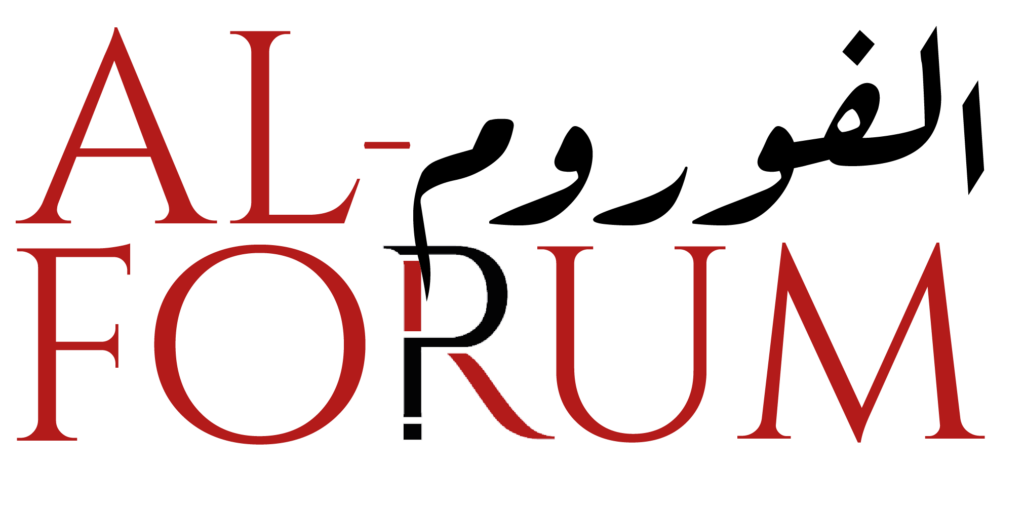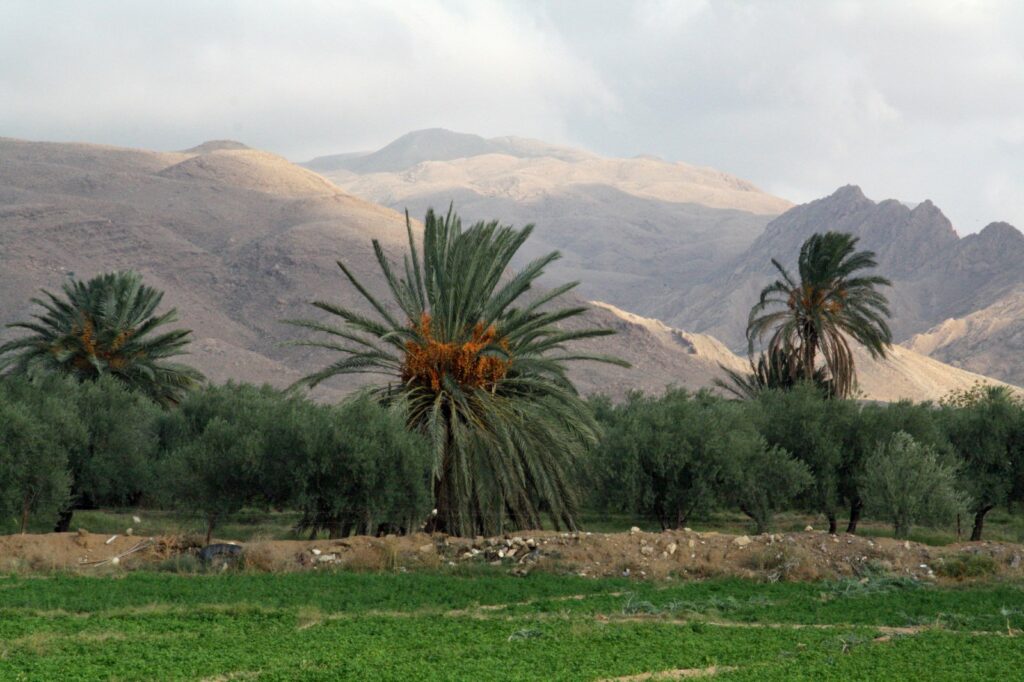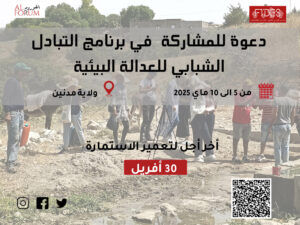The Agricultural Crisis in Gafsa:
Do we need an emergency government rescue plan to deal with it?
By Rihab Mabrouki
The agricultural sector is one of the pillars of national sovereignty and the key sector for achieving complete and sustainable development because it affects crucial economic aspects. In Tunisia, this sector faces many difficulties preventing its thriving, progress, and high productivity, especially the wheat harvest. The State imports wheat in enormous quantities for consumption and to balance the shortage of its local production. The region of Gafsa, in southwestern Tunisia, is not immune to all these problems, which the State ignores and has not made it a priority for decades. Today the farmer finds himself surrounded by several challenges that do not consider his economic situation, which prioritizes the need to change the State’s policies towards the agricultural sector, to help them avoid negative repercussions on the national and global level, especially with the spread of the Corona pandemic and its impacts on all the sectors in various countries.
Agriculture is the solution
In mid-2020, the Tunisian Union of Agriculture and Fisheries published a book entitled “Agriculture is the solution for strengthening our sovereignty and developing our economy.” It addressed the main difficulties and challenges facing Tunisia’s agricultural sector and farmers, according to the book, the sector represents a livelihood for over than 500,000 farmers and 60,000 sailors and indirectly provides employment for over than 2.5 million workers.
Based on the previous data, the importance of this sector manifests in its contribution to economic development through labour absorption, food security and improving people’s living standards.
However, the problems faced by the agriculture sector in Gafsa remains a barrier to its progress, especially given the government’s failure to protect some crops from being lost to the scarcity of rainfall in the south-west and the inability of farmers to cover the cost of watering to cope with drought, as well as the severe shortage of forage and barley. These are the difficulties the farmer is experiencing today to provide the survival items of his crops.
In addition, the Ministry of Agriculture is reluctant to protect livestock by ignoring seasonal vaccination.
We should also mention the entry of major investors and their monopoly on the market. That explains why today’s farmers face challenges that have made them reluctant to produce and serve the land.

Some of the crops in the region of Gafsa
Gafsa’s oases are thirsty
The oases area in Tunisia is 40,000 hectares, they are classified as coastal oases located in the regions of Gabes and Djerba, others are classified as mountain oases located in Tozeur, especially in the regions of Dimas and Tamaghza. Alongside the oases of the continental region located in the State of southern Gafsa, between al-Kasar and al-Kitar, measuring about 575 hectares, almost 500 of which are watered with treated water (sewage), as reported by Hatem Khalfallah, the President of the Qadus Society for the Protection of Oases and the Maintenance of the City.
Despite the diversity of the water resources of the oasis sector, such as Ein al-Fawara, Ein al-Robaa, Ein al-Tertesh, Ein al-Ayed, and Ein Zalani, which Al-Kasr Oasis supplies, the problem of water scarcity remains a barrier for the farmer to maintain a productive development in this area.
According to the farming delegation in Gafsa, about 70% of the water resources are exploited and used for irrigation. This water divides into State’s wells and other wells managed by water development associations or as they are called water pools, including the Tertesh Well, the Bohabib Well and the Sidi Salem Well in Al-Kasr.
The irrigation of the oases areas usually requires approximately 300 litres per second, of which the farming delegation provides 180 litres per second, and the water pools handle 120 litres per second.
However, with the growing population and increasing consumption, farmers face water shortages, mainly due to the immense oases area in Al-Kasr, 600 hectares during the 1980s to 1200 today, adding to scarcity of rainfall and drought in the region for several years.
According to Hatem Khalfallah, this lack of productivity is getting worse due to the failure of the Agricultural Bank to respond to the demands of the small farmers and to finance them regarding that their lands are small and their inability to repay loan surpluses.
Other forms of monopoly through multiple distribution routes non-controlled by the State and the adoption of mediation rather than product-to-consumer sales policy. In addition to the problems created by the citizens, such as urban sprawl at the expense of the oases spaces and chaotic construction, the reasons why today’s farmer is reluctant to produce and serve the land, leaving his product devastated due to his inability to defeat these challenges on his own.
The Major Farm Problems in Gafsa
According to the Regional Delegation for Agricultural Development, the cultivated areas in Gafsa are 33.639 hectares, involving wheat, barley and fodder. According to the same source, there are an estimated 92.938 hectares of fruit trees, including 31.23 irrigated areas and 59.289 hectares of olive trees. In addition, livestock including sheep, cows, goats, hooves, rabbits, quail and beekeepers represents the livelihood of hundreds of farmers.
However, given the importance of the agriculture sector, its diversity, and its ability to support the national economy, the material challenges stand in the way of sustainable production. The problem of promotion faced by farmers is evidence of the absence of a clear State strategy to restore the surplus production among farmers, which often forces them to destroy and throw milk on the side of the road, as confirmed to us by the general agriculture engineer Hakim Denari.
The farmer also faces the problem of rising costs through increased feed prices, which requires State’s intervention through subsidies to reduce the expenses.
In its 2020 report, the Regional Delegation of Rural Development in Gafsa classifies indebtedness as the most striking problem that cripples the farming sector. Indebtedness is an obstacle to investments because of the low contribution of the banking sector in the financing of banking projects and failure to settle the common lands of the governing councils which is a barrier to farmers’ access to concessions, also the inability of the state to respond to the demands for the construction of wells to launch private projects.
Cattle and cows are facing a deteriorating situation
Livestock, in turn, faces series of problems, which are part of the crisis that the agriculture sector generally has in Gafsa. In this context, Mr. Moncef Salem, a farmer and civil activist, talks about the problems of the sheep sector, the numbers of which are getting fewer because of the lack of pastures and the rising prices of fodder, such as barley, which has risen from 29 to 40 dinars in few years.
In addition, the Livestock sector did not meet the needs of the farmers, and the Grain Office tended to provide fodder through mediation, consequently creating a monopoly in the sector.
All these reasons made the farmer tend to raise cows, which, in turn, was no less expensive for him, he found himself confronted with the same problems he faced in raising sheep by doubling the price of fodder from 35 to nearly 60.
This volatility in prices is due to the State’s policy, which is no longer able to deal with these irregular increases.
According to Mr. Moncef Salem, a policy of mediation between farmers and milk-gathering centres has led to the destruction of the cattle-raising sector due to poor earnings.
Even though the farmers engaged in various forms of protest and negotiation sessions with the relevant authorities, represented by the Ministry of Agriculture, which condemned the miserable situation of the agricultural sector and tried to find immediate solutions to end the sector’s crisis, yet the policy of procrastination remained the same, as expressed by Mr. Moncef Salim. He stressed that the solutions put forward by the concerned authorities could only be considered temporary solutions to absorb the farmer’s anger without providing any alternative that would solve this sector’s problems and save crops from waste.
Failure to resolve the crisis.
In the context of the agriculture sector crisis in Gafsa, a question raises about the role of the Ministry of Agriculture, Water Resources and Fisheries in the observation, guidance and support process, particularly in the monitoring of monopolists and private investors in this sector, who, according to farmers, do not miss the opportunity to achieve imaginary incomes at the expense of the small farmers’ fragile economic situation.
Therefore, it is the responsibility of the Ministry of Agriculture to act to stop legal breaches in this sector.
Talking about the agriculture sector and its marginalization and the misbehaviour in its resources and wealth is not a marginal issue. It requires an emergency Government rescue plan that fulfills its commitments to small farmers to help them overcome the problems that prevent progress in their crops.
The support of the Agricultural sector and the defence of the farmers’ rights are among the interests of the Association of the Tunisian Forum for Economic and Social Rights, therefore, the Forum’s call to respond to the demands of farmers and take into account their economic needs would offer permanent solutions to various problems, and that requires radical political changes in agricultural policies and practices.
The farming sector in the region of Gafsa should have crucial importance if we are willing to maintain an agricultural balance on which generations will depend now and in the future.







